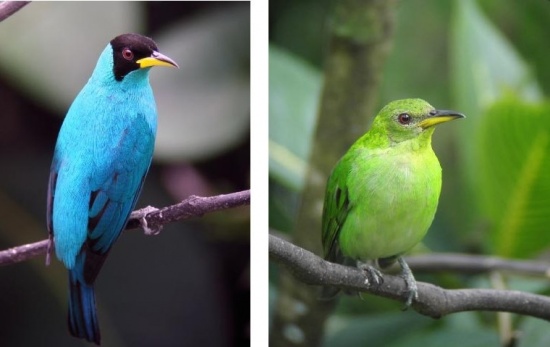m |
|||
| Line 1: | Line 1: | ||
;Chlorophanes spiza | ;Chlorophanes spiza | ||
| − | [[Image:Green_Honeycreeper.jpg|thumb| | + | [[Image:Green_Honeycreeper.jpg|thumb|550px|right|Photo by Dave B Smith <br />at Asa Wright, Trinidad]] |
==Description== | ==Description== | ||
| − | Male on left - Female on right. | + | The image shows Male on left - Female on right. Male is overall blue-green with a black hood which covers the crown and the auriculars and goes down into a tip on the side of the neck. Bill is slender and decurved, yellow except for the upper half of upper mandible, which is black. Eye is red in adult, reddish-brown in the immature which otherwise looks like a female. Female is overall green with the bill imitating the bill of the male. Both sexes have gray legs. |
| − | == | + | |
| − | + | Note: this particular image exagerates the blue in the plumage of the male, look at other images in the gallery by following the link at the end of this entry | |
| + | ==Distribution== | ||
| + | Green Honeycreeper is found from Mexico through Central America and South America to Ecuador, Peru and Bolivia, and east through Venezuela and the Guianas to eastern Brazil; also in Trinidad. | ||
| + | ==Taxonomy== | ||
| + | Seven subspecies are included in Clements Checklist of Birds of the World. Honeycrepers are grouped with Tanagers | ||
| + | ==Habitat== | ||
| + | Humid forest, mainly in the canopy | ||
| + | ==Behavior== | ||
| + | Eats fruits, a little nectar and the occational insect. Will also frequent fruit feeders at for example Asa Wrigth in Trinidad. | ||
==External Links== | ==External Links== | ||
| − | + | {{GSearch|Chlorophanes+spiza}} | |
[[Category:Birds]] | [[Category:Birds]] | ||
Revision as of 01:46, 12 June 2007
- Chlorophanes spiza
Description
The image shows Male on left - Female on right. Male is overall blue-green with a black hood which covers the crown and the auriculars and goes down into a tip on the side of the neck. Bill is slender and decurved, yellow except for the upper half of upper mandible, which is black. Eye is red in adult, reddish-brown in the immature which otherwise looks like a female. Female is overall green with the bill imitating the bill of the male. Both sexes have gray legs.
Note: this particular image exagerates the blue in the plumage of the male, look at other images in the gallery by following the link at the end of this entry
Distribution
Green Honeycreeper is found from Mexico through Central America and South America to Ecuador, Peru and Bolivia, and east through Venezuela and the Guianas to eastern Brazil; also in Trinidad.
Taxonomy
Seven subspecies are included in Clements Checklist of Birds of the World. Honeycrepers are grouped with Tanagers
Habitat
Humid forest, mainly in the canopy
Behavior
Eats fruits, a little nectar and the occational insect. Will also frequent fruit feeders at for example Asa Wrigth in Trinidad.




